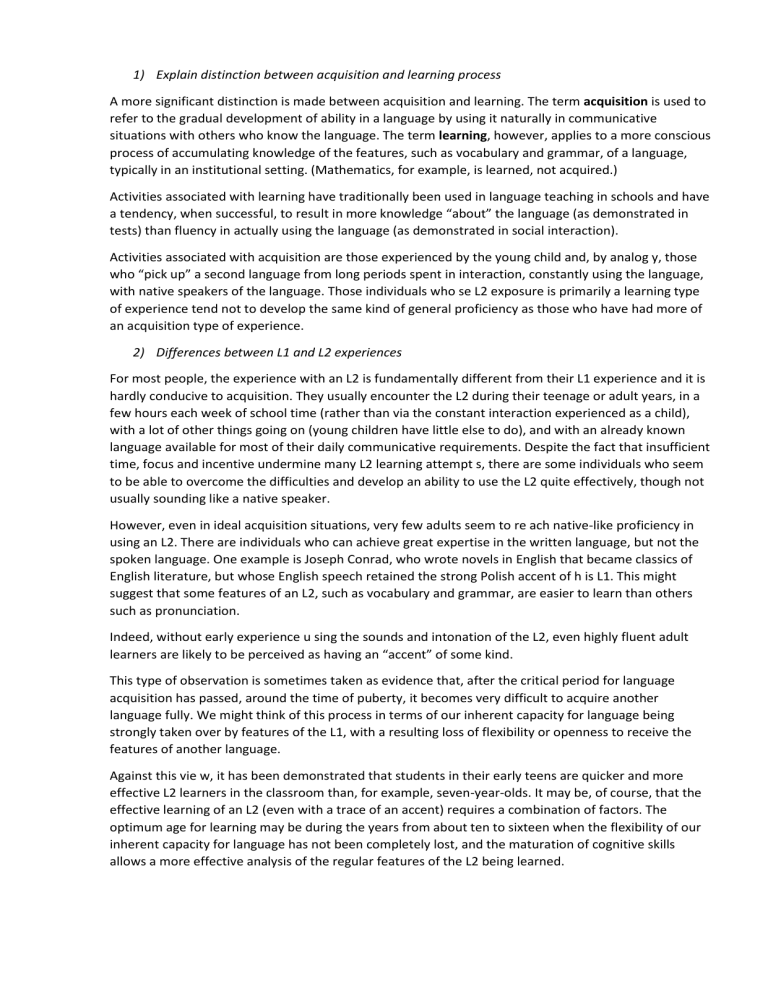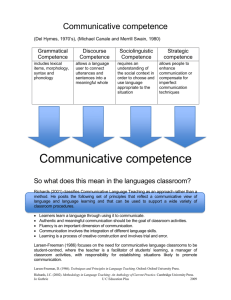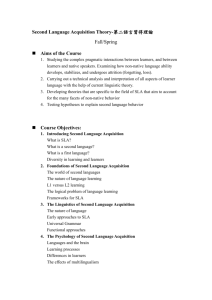
1) Explain distinction between acquisition and learning process A more significant distinction is made between acquisition and learning. The term acquisition is used to refer to the gradual development of ability in a language by using it naturally in communicative situations with others who know the language. The term learning, however, applies to a more conscious process of accumulating knowledge of the features, such as vocabulary and grammar, of a language, typically in an institutional setting. (Mathematics, for example, is learned, not acquired.) Activities associated with learning have traditionally been used in language teaching in schools and have a tendency, when successful, to result in more knowledge “about” the language (as demonstrated in tests) than fluency in actually using the language (as demonstrated in social interaction). Activities associated with acquisition are those experienced by the young child and, by analog y, those who “pick up” a second language from long periods spent in interaction, constantly using the language, with native speakers of the language. Those individuals who se L2 exposure is primarily a learning type of experience tend not to develop the same kind of general proficiency as those who have had more of an acquisition type of experience. 2) Differences between L1 and L2 experiences For most people, the experience with an L2 is fundamentally different from their L1 experience and it is hardly conducive to acquisition. They usually encounter the L2 during their teenage or adult years, in a few hours each week of school time (rather than via the constant interaction experienced as a child), with a lot of other things going on (young children have little else to do), and with an already known language available for most of their daily communicative requirements. Despite the fact that insufficient time, focus and incentive undermine many L2 learning attempt s, there are some individuals who seem to be able to overcome the difficulties and develop an ability to use the L2 quite effectively, though not usually sounding like a native speaker. However, even in ideal acquisition situations, very few adults seem to re ach native-like proficiency in using an L2. There are individuals who can achieve great expertise in the written language, but not the spoken language. One example is Joseph Conrad, who wrote novels in English that became classics of English literature, but whose English speech retained the strong Polish accent of h is L1. This might suggest that some features of an L2, such as vocabulary and grammar, are easier to learn than others such as pronunciation. Indeed, without early experience u sing the sounds and intonation of the L2, even highly fluent adult learners are likely to be perceived as having an “accent” of some kind. This type of observation is sometimes taken as evidence that, after the critical period for language acquisition has passed, around the time of puberty, it becomes very difficult to acquire another language fully. We might think of this process in terms of our inherent capacity for language being strongly taken over by features of the L1, with a resulting loss of flexibility or openness to receive the features of another language. Against this vie w, it has been demonstrated that students in their early teens are quicker and more effective L2 learners in the classroom than, for example, seven-year-olds. It may be, of course, that the effective learning of an L2 (even with a trace of an accent) requires a combination of factors. The optimum age for learning may be during the years from about ten to sixteen when the flexibility of our inherent capacity for language has not been completely lost, and the maturation of cognitive skills allows a more effective analysis of the regular features of the L2 being learned. 3) Components of communicative competence Communicative competence can be defined as the general ability to use language accurately, appropriately, and flexibly. The first component is grammatical competence, which involves the accurate use of words and structures. Concentration on grammatical competence only, however, will not provide the learner with the ability to interpret or produce L2 expressions appropriately. The ability to use appropriate language is the second component, called sociolinguistic competence. It enables the learner to know when to say Can I have some water? versus Give me some water! according to the social context. Much of what is discussed in terms of pragmatics has to become familiar in the cultural context of the L2 if the learner is to develop sociolinguistic competence. The third component is called strategic competence. This is the ability to organize a message effectively and to compensate, via strategies, for any difficulties. In L2 use, learners inevitably experience moments when there is a gap between communicative intent and their ability to express that intent. Some learners may just stop talking (bad idea), whereas others will try to express themselves using a communication strategy (good idea). For example, a Dutch L1 speaker wanted to refer to een hoefijzer in English, but didn’t know the English word. So, she used a communication strategy. She created a way of referring to the object by using vocabulary she already knew, saying the things that horses wear under their feet, the iron things and the listener understood immediately what she meant (horse shoes). This flexibility in L2 use is a key element in communicative success. In essence, strategic competence is the ability to overcome potential communication problems in interaction






